2022 HYUNDAI SANTA CRUZ seats
[x] Cancel search: seatsPage 90 of 598
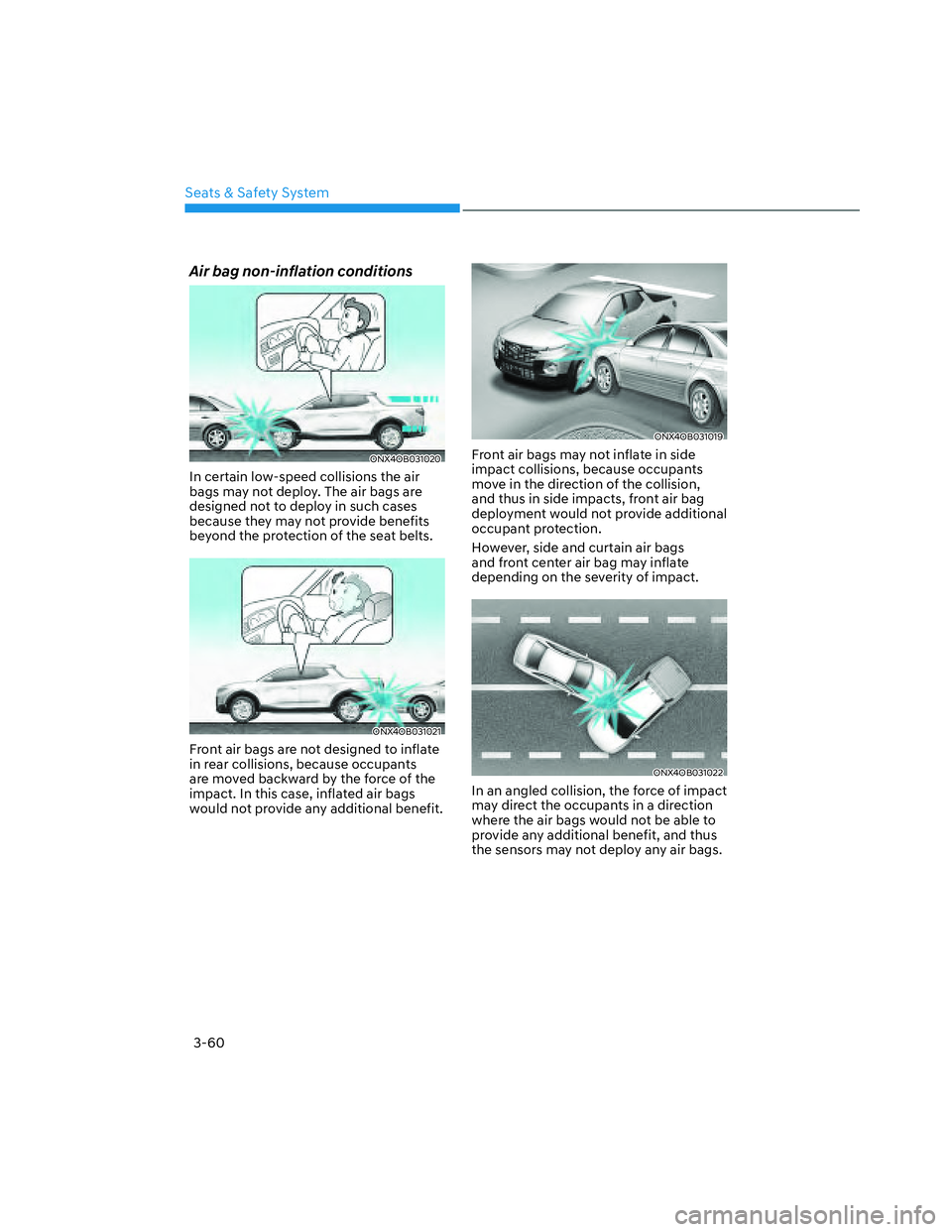
Seats & Safety System
3-60
Air bag non-inflation conditions
ONX4OB031020ONX4OB031020
In certain low-speed collisions the air
bags may not deploy. The air bags are
designed not to deploy in such cases
because they may not provide benefits
beyond the protection of the seat belts.
ONX4OB031021ONX4OB031021
Front air bags are not designed to inflate
in rear collisions, because occupants
are moved backward by the force of the
impact. In this case, inflated air bags
would not provide any additional benefit.
ONX4OB031019ONX4OB031019
Front air bags may not inflate in side
impact collisions, because occupants
move in the direction of the collision,
and thus in side impacts, front air bag
deployment would not provide additional
occupant protection.
However, side and curtain air bags
and front center air bag may inflate
depending on the severity of impact.
ONX4OB031022ONX4OB031022
In an angled collision, the force of impact
may direct the occupants in a direction
where the air bags would not be able to
provide any additional benefit, and thus
the sensors may not deploy any air bags.
Page 92 of 598
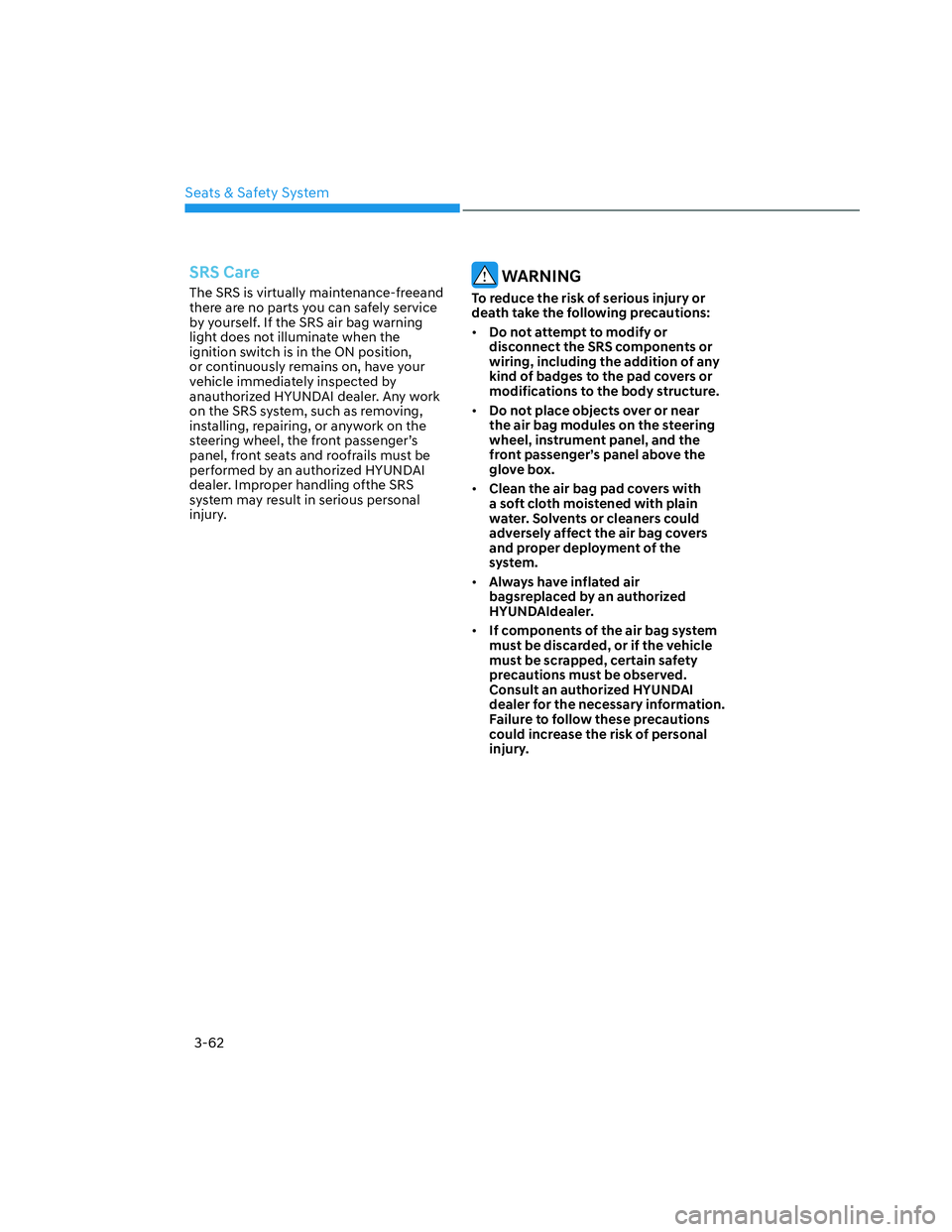
Seats & Safety System
3-62
SRS Care
The SRS is virtually maintenance-freeand
there are no parts you can safely service
by yourself. If the SRS air bag warning
light does not illuminate when the
ignition switch is in the ON position,
or continuously remains on, have your
vehicle immediately inspected by
anauthorized HYUNDAI dealer. Any work
on the SRS system, such as removing,
installing, repairing, or anywork on the
steering wheel, the front passenger’s
panel, front seats and roofrails must be
performed by an authorized HYUNDAI
dealer. Improper handling ofthe SRS
system may result in serious personal
injury. WARNING
To reduce the risk of serious injury or
death take the following precautions:
• Do not attempt to modify or
disconnect the SRS components or
wiring, including the addition of any
kind of badges to the pad covers or
modifications to the body structure.
• Do not place objects over or near
the air bag modules on the steering
wheel, instrument panel, and the
front passenger’s panel above the
glove box.
• Clean the air bag pad covers with
a soft cloth moistened with plain
water. Solvents or cleaners could
adversely affect the air bag covers
and proper deployment of the
system.
• Always have inflated air
bagsreplaced by an authorized
HYUNDAIdealer.
• If components of the air bag system
must be discarded, or if the vehicle
must be scrapped, certain safety
precautions must be observed.
Consult an authorized HYUNDAI
dealer for the necessary information.
Failure to follow these precautions
could increase the risk of personal
injury.
Page 93 of 598
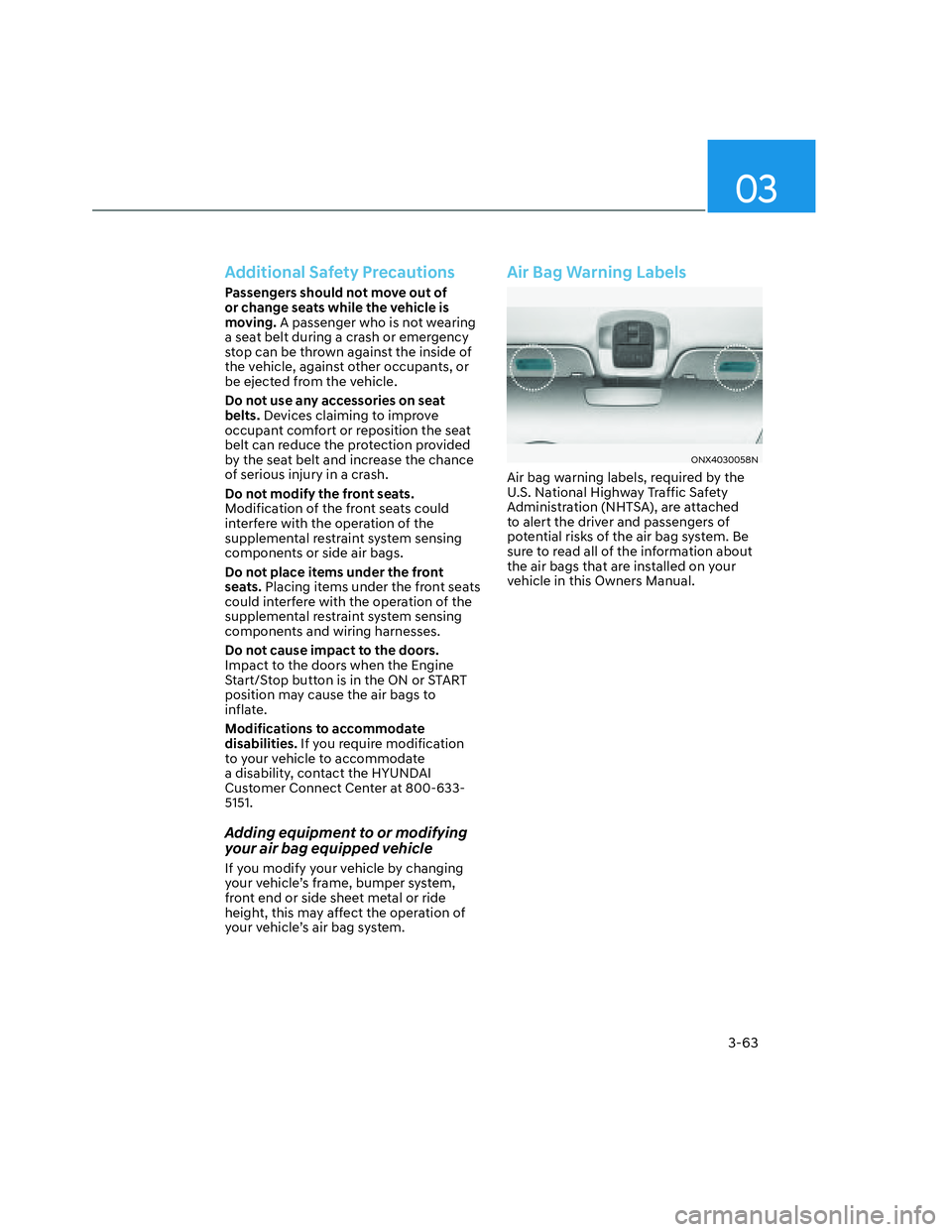
03
3-63
Additional Safety Precautions
Passengers should not move out of
or change seats while the vehicle is
moving. A passenger who is not wearing
a seat belt during a crash or emergency
stop can be thrown against the inside of
the vehicle, against other occupants, or
be ejected from the vehicle.
Do not use any accessories on seat
belts. Devices claiming to improve
occupant comfort or reposition the seat
belt can reduce the protection provided
by the seat belt and increase the chance
of serious injury in a crash.
Do not modify the front seats.
Modification of the front seats could
interfere with the operation of the
supplemental restraint system sensing
components or side air bags.
Do not place items under the front
seats. Placing items under the front seats
could interfere with the operation of the
supplemental restraint system sensing
components and wiring harnesses.
Do not cause impact to the doors.
Impact to the doors when the Engine
Start/Stop button is in the ON or START
position may cause the air bags to
inflate.
Modifications to accommodate
disabilities. If you require modification
to your vehicle to accommodate
a disability, contact the HYUNDAI
Customer Connect Center at 800-633-
5151.
Adding equipment to or modifying
your air bag equipped vehicle
If you modify your vehicle by changing
your vehicle’s frame, bumper system,
front end or side sheet metal or ride
height, this may affect the operation of
your vehicle’s air bag system.
Air Bag Warning Labels
ONX4030058NONX4030058N
Air bag warning labels, required by the
U.S. National Highway Traffic Safety
Administration (NHTSA), are attached
to alert the driver and passengers of
potential risks of the air bag system. Be
sure to read all of the information about
the air bags that are installed on your
vehicle in this Owners Manual.
Page 194 of 598
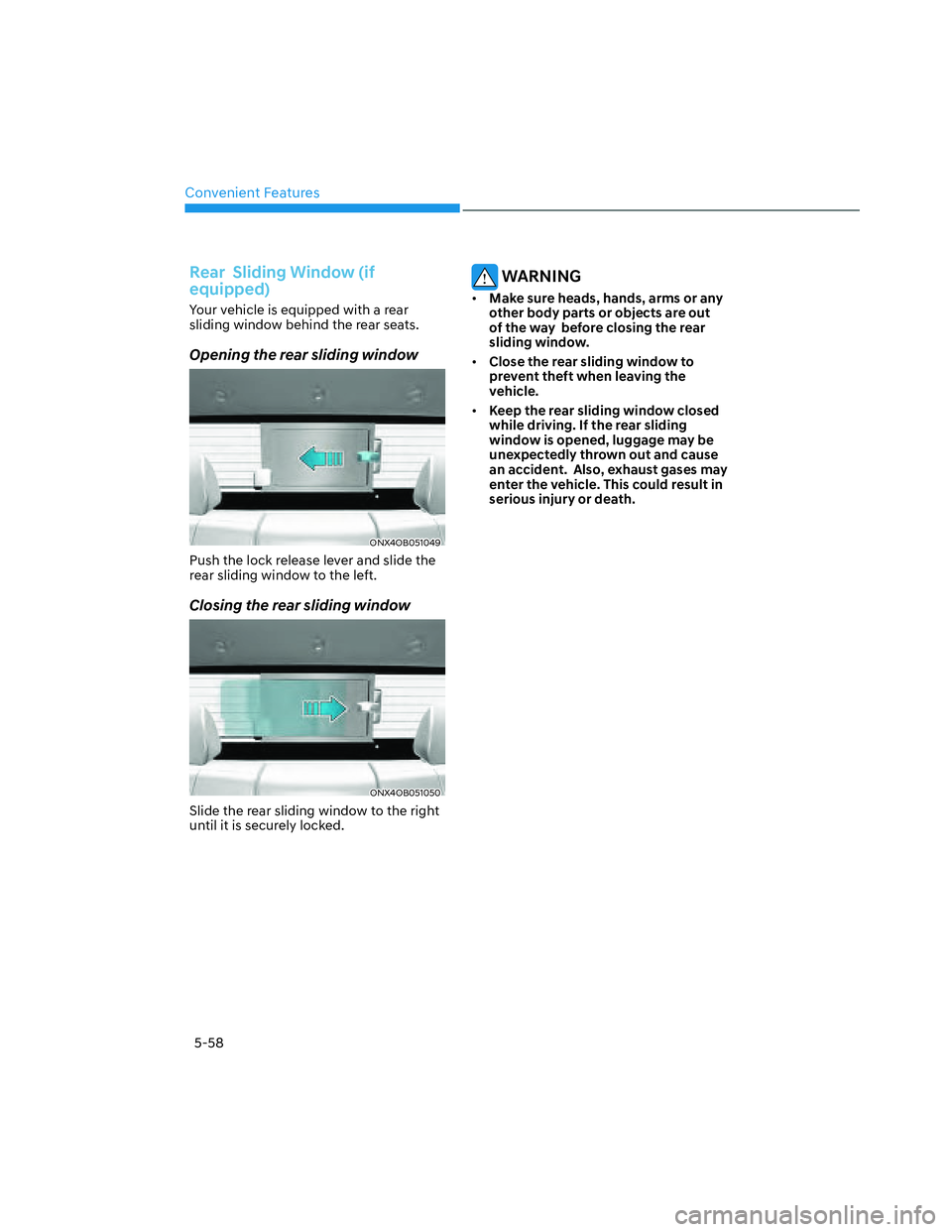
Convenient Features
5-58
Rear Sliding Window (if
equipped)
Your vehicle is equipped with a rear
sliding window behind the rear seats.
Opening the rear sliding window
ONX4OB051049ONX4OB051049
Push the lock release lever and slide the
rear sliding window to the left.
Closing the rear sliding window
ONX4OB051050ONX4OB051050
Slide the rear sliding window to the right
until it is securely locked.
WARNING
• Make sure heads, hands, arms or any
other body parts or objects are out
of the way before closing the rear
sliding window.
• Close the rear sliding window to
prevent theft when leaving the
vehicle.
• Keep the rear sliding window closed
while driving. If the rear sliding
window is opened, luggage may be
unexpectedly thrown out and cause
an accident. Also, exhaust gases may
enter the vehicle. This could result in
serious injury or death.
Page 214 of 598
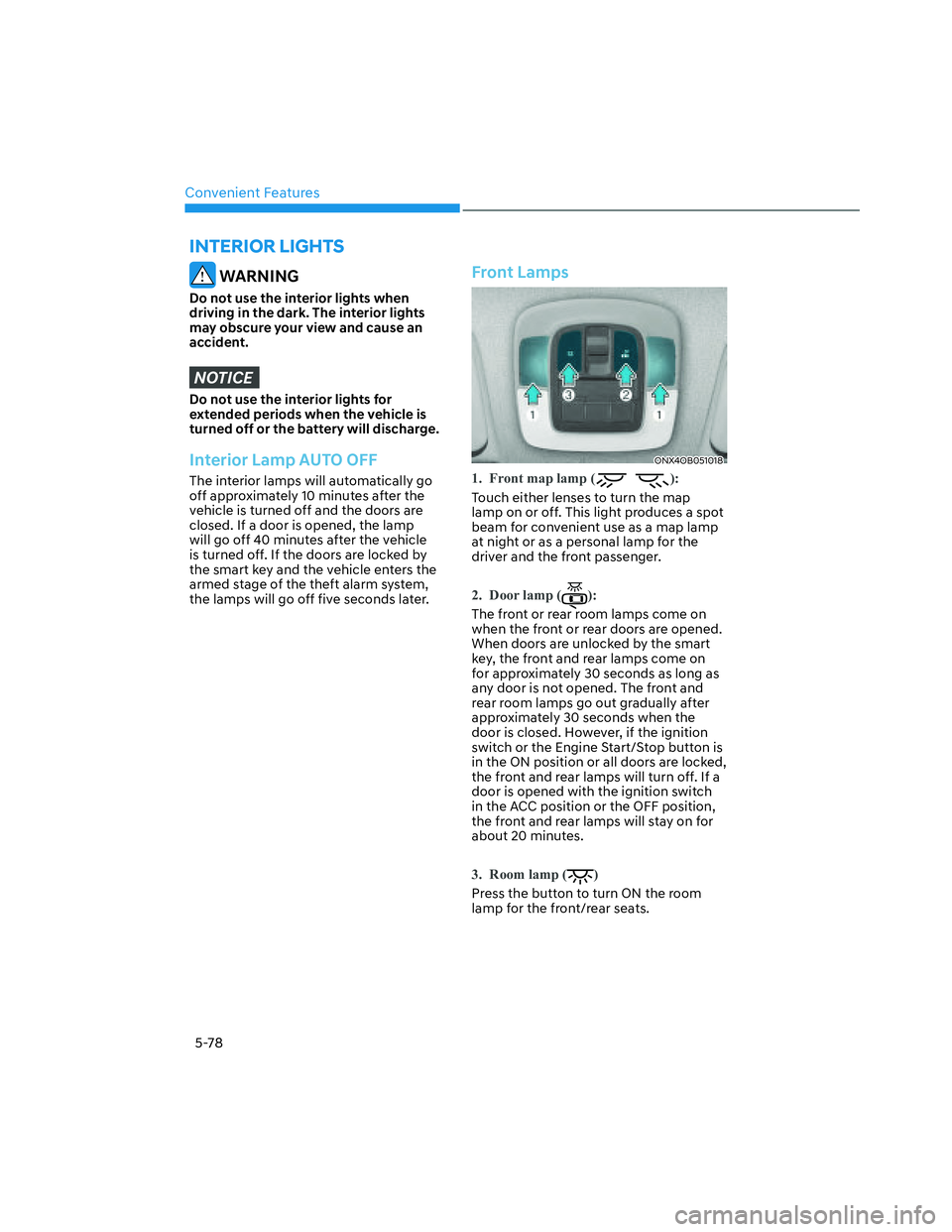
Convenient Features
5-78
INTERIOR LIGHTS
WARNING
Do not use the interior lights when
driving in the dark. The interior lights
may obscure your view and cause an
accident.
NOTICE
Do not use the interior lights for
extended periods when the vehicle is
turned off or the battery will discharge.
Interior Lamp AUTO OFF
The interior lamps will automatically go
off approximately 10 minutes after the
vehicle is turned off and the doors are
closed. If a door is opened, the lamp
will go off 40 minutes after the vehicle
is turned off. If the doors are locked by
the smart key and the vehicle enters the
armed stage of the theft alarm system,
the lamps will go off five seconds later.
Front Lamps
ONX4OB051018ONX4OB051018
1. Front map lamp ():
Touch either lenses to turn the map
lamp on or off. This light produces a spot
beam for convenient use as a map lamp
at night or as a personal lamp for the
driver and the front passenger.
2. Door lamp ():
The front or rear room lamps come on
when the front or rear doors are opened.
When doors are unlocked by the smart
key, the front and rear lamps come on
for approximately 30 seconds as long as
any door is not opened. The front and
rear room lamps go out gradually after
approximately 30 seconds when the
door is closed. However, if the ignition
switch or the Engine Start/Stop button is
in the ON position or all doors are locked,
the front and rear lamps will turn off. If a
door is opened with the ignition switch
in the ACC position or the OFF position,
the front and rear lamps will stay on for
about 20 minutes.
3. Room lamp ()
Press the button to turn ON the room
lamp for the front/rear seats.
Page 254 of 598
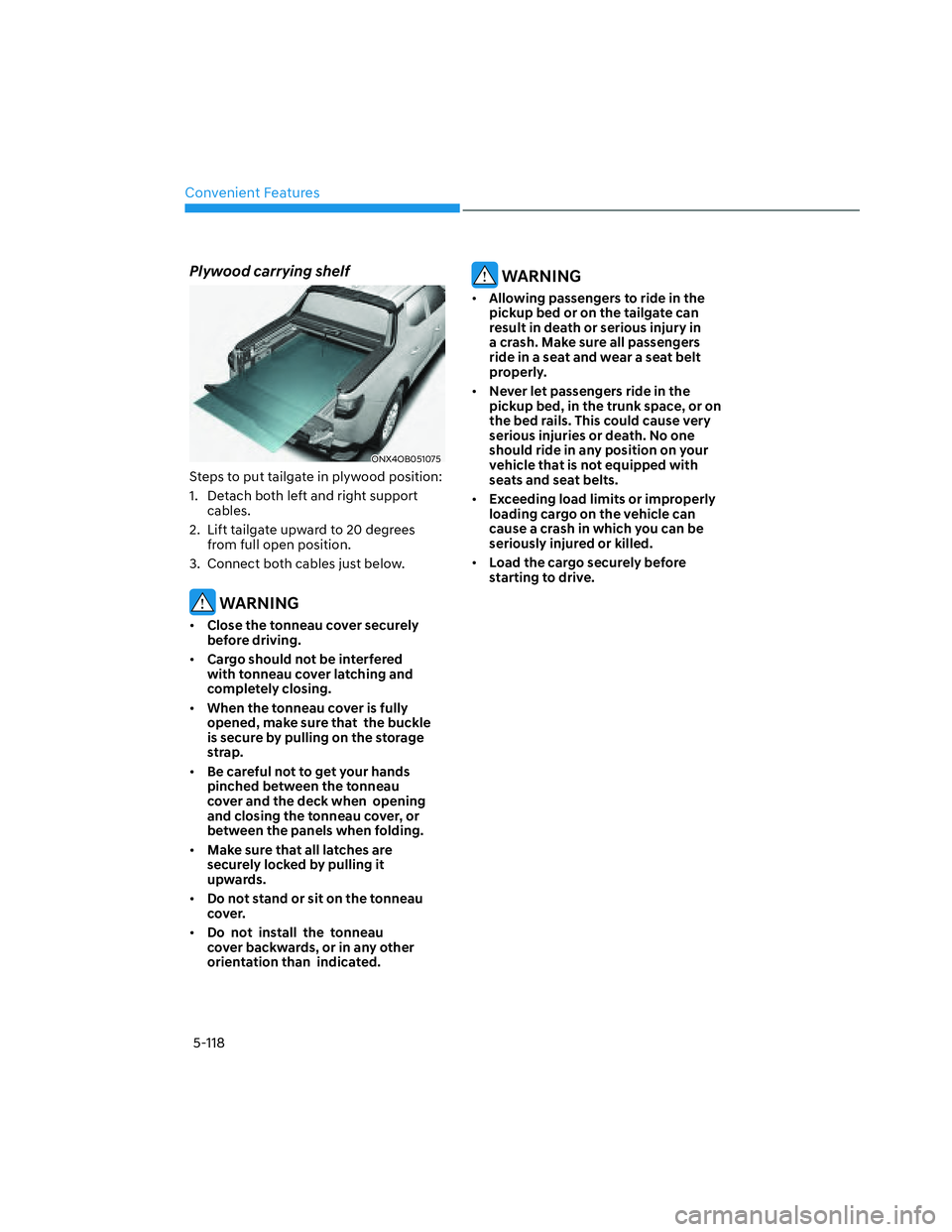
Convenient Features
5-118
Plywood carrying shelf
ONX4OB051075ONX4OB051075
Steps to put tailgate in plywood position:
1. Detach both left and right support
cables.
2. Lift tailgate upward to 20 degrees
from full open position.
3. Connect both cables just below.
WARNING
• Close the tonneau cover securely
before driving.
• Cargo should not be interfered
with tonneau cover latching and
completely closing.
• When the tonneau cover is fully
opened, make sure that the buckle
is secure by pulling on the storage
strap.
• Be careful not to get your hands
pinched between the tonneau
cover and the deck when opening
and closing the tonneau cover, or
between the panels when folding.
• Make sure that all latches are
securely locked by pulling it
upwards.
• Do not stand or sit on the tonneau
cover.
• Do not install the tonneau
cover backwards, or in any other
orientation than indicated.
WARNING
• Allowing passengers to ride in the
pickup bed or on the tailgate can
result in death or serious injury in
a crash. Make sure all passengers
ride in a seat and wear a seat belt
properly.
• Never let passengers ride in the
pickup bed, in the trunk space, or on
the bed rails. This could cause very
serious injuries or death. No one
should ride in any position on your
vehicle that is not equipped with
seats and seat belts.
• Exceeding load limits or improperly
loading cargo on the vehicle can
cause a crash in which you can be
seriously injured or killed.
• Load the cargo securely before
starting to drive.
Page 258 of 598
![HYUNDAI SANTA CRUZ 2022 Owners Manual Convenient Features
5-122
Tie Down
Tie Down Locations
ONX4OB051026ONX4OB051026
[A] Fixed Tie Down
[B] D-Ring
You can secure cargo to the vehicle using
hooks, ropes and straps with heavy duty
tie dow HYUNDAI SANTA CRUZ 2022 Owners Manual Convenient Features
5-122
Tie Down
Tie Down Locations
ONX4OB051026ONX4OB051026
[A] Fixed Tie Down
[B] D-Ring
You can secure cargo to the vehicle using
hooks, ropes and straps with heavy duty
tie dow](/manual-img/35/41171/w960_41171-257.png)
Convenient Features
5-122
Tie Down
Tie Down Locations
ONX4OB051026ONX4OB051026
[A] Fixed Tie Down
[B] D-Ring
You can secure cargo to the vehicle using
hooks, ropes and straps with heavy duty
tie downs from various location on the
pickup bed.
• Fixed Tie Down also acts as a Cleat for
looping rope.
• D-Ring can be rotated about the bolt
and the bracket.
• D-Ring and Fixed Tie Down can be
hooked through their openings.
Information
• Put cargo evenly on the pickup bed.
Place the heaviest items on the bottom
and as far forward as possible of the
rear axle. Tie down and secure all items
that could be thrown out of the vehicle
during a crash or sudden stop.
• If you stack items higher than the bed
sides, tailgate, or back window, secure
them with a net or cover. This will
reduce the risk of items being thrown
out of the pickup bed during a crash or
sudden stop.
CAUTION
• Load the cargo securely before
starting to drive.
WARNING
• Do not exceed 440 lbs. (200 kgf) load
on a tie down.
WARNING
• Allowing passengers to ride in the
pickup bed or on the tailgate can
result in death or serious injury in
a crash. Make sure all passengers
ride in a seat and wear a seat belt
properly
• Never let passengers ride in the
pickup bed, in the trunk space, or on
the bed rails. This could cause very
serious injuries or death. No one
should ride in any position on your
vehicle that is not equipped with
seats and seat belts.
• Exceeding load limits or improperly
loading cargo on the vehicle can
cause a crash in which could result in
serious injury or death.
• Load the cargo carefully before
starting to drive.
Page 341 of 598
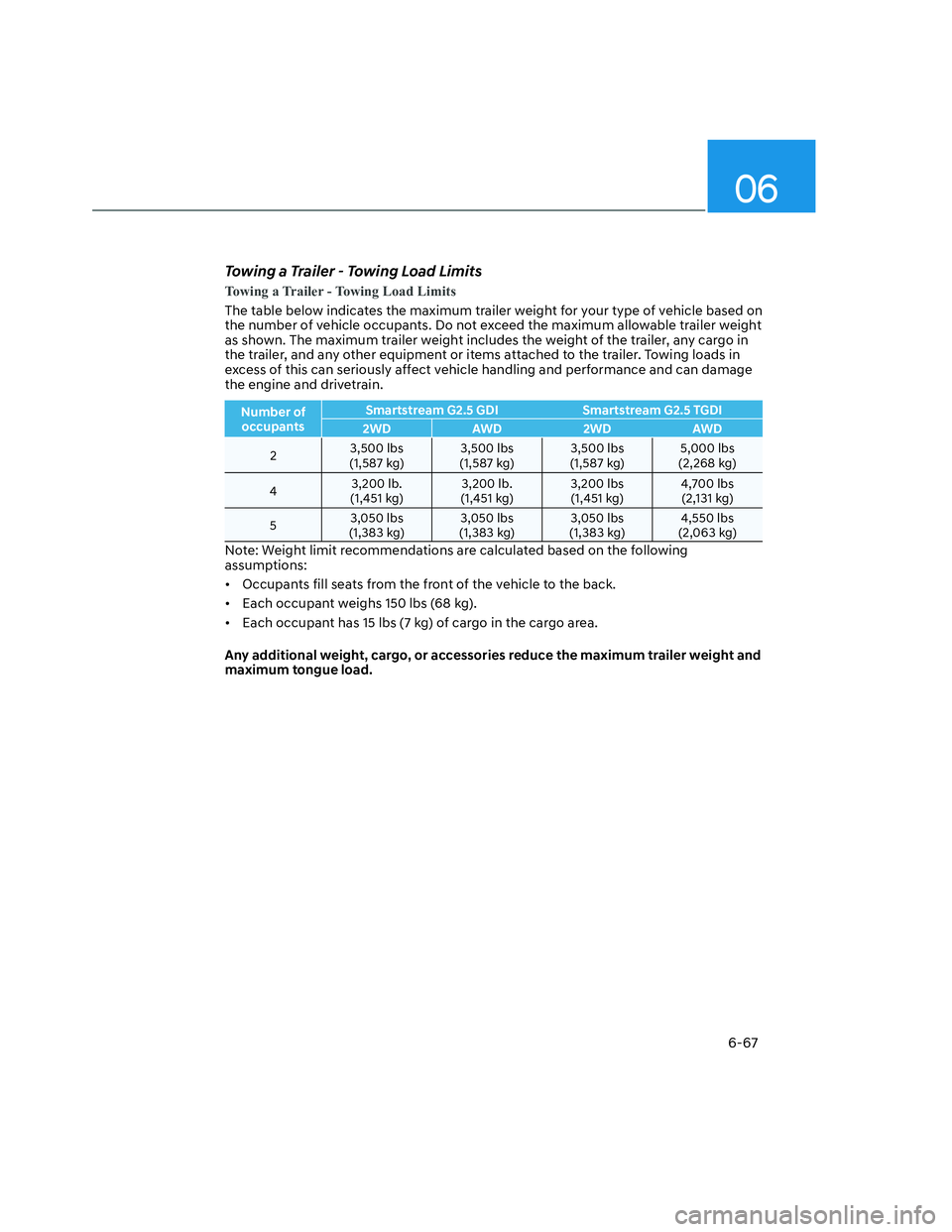
06
6-67
Towing a Trailer - Towing Load Limits
Towing a Trailer - Towing Load Limits
The table below indicates the maximum trailer weight for your type of vehicle based on
the number of vehicle occupants. Do not exceed the maximum allowable trailer weight
as shown. The maximum trailer weight includes the weight of the trailer, any cargo in
the trailer, and any other equipment or items attached to the trailer. Towing loads in
excess of this can seriously affect vehicle handling and performance and can damage
the engine and drivetrain.
Number of
occupantsSmartstream G2.5 GDI Smartstream G2.5 TGDI
2WD AWD 2WD AWD
23,500 lbs
(1,587 kg)3,500 lbs
(1,587 kg)3,500 lbs
(1,587 kg)5,000 lbs
(2,268 kg)
43,200 lb.
(1,451 kg)3,200 lb.
(1,451 kg)3,200 lbs
(1,451 kg)4,700 lbs
(2,131 kg)
53,050 lbs
(1,383 kg)3,050 lbs
(1,383 kg)3,050 lbs
(1,383 kg)4,550 lbs
(2,063 kg)
Note: Weight limit recommendations are calculated based on the following
assumptions:
• Occupants fill seats from the front of the vehicle to the back.
• Each occupant weighs 150 lbs (68 kg).
• Each occupant has 15 lbs (7 kg) of cargo in the cargo area.
Any additional weight, cargo, or accessories reduce the maximum trailer weight and
maximum tongue load.